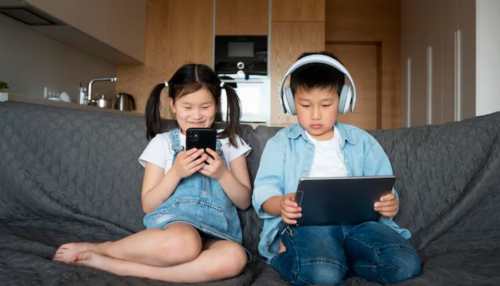- News>
- Health
Screen Time And Children`s Eye Health: Balancing Technology Use

Digital eye strain, also known as computer vision syndrome, is a condition that arises from prolonged screen use. Symptoms include eye discomfort, dryness, headaches, blurred vision, and neck and shoulder pain.
In today’s digital age, technology is an integral part of our daily lives, and children are no exception. From educational apps to entertainment, screens are everywhere. While technology offers numerous benefits, excessive screen time can harm children’s eye health.
As parents, balancing technology use is essential to protect your child's vision and overall well-being. Dr Aditi Sapovadia, Paediatric Ophthalmologist, Squint and Cataract Consultant at Netradeep Maxivision Eye Hospital, Rajkot shares how to balance technology use to protect children's eye health.
1. Understanding Digital Eye Strain
Digital eye strain, also known as computer vision syndrome, is a condition that arises from prolonged screen use. Symptoms include eye discomfort, dryness, headaches, blurred vision, and neck and shoulder pain. Children may be more susceptible because their eyes are still developing. Prolonged screen time without breaks can exacerbate these symptoms, leading to long-term vision problems.
2. Implementing the 20-20-20 Rule
One effective way to mitigate digital eye strain is by implementing the 20-20-20 rule. Every 20 minutes, encourage your child to take a 20-second break and look at something 20 feet away. This simple practice helps relax the eye muscles, reduces eye fatigue, and promotes better eye health. Setting timers or reminders can help children remember to take these breaks, fostering healthy screen habits.
3. Ensuring Proper Lighting and Ergonomics
Proper lighting and ergonomics play a crucial role in reducing eye strain. Ensure that the screen is at eye level and about an arm's length away from your child’s face. Adjust the brightness and contrast of the screen to comfortable levels and reduce glare by using screen filters or adjusting the room lighting. Creating a comfortable and eye-friendly environment can significantly alleviate the strain on your child’s eyes.
4. Encouraging Outdoor Activities
Balancing screen time with outdoor activities is vital for children's eye health. Outdoor play not only provides a break from screens but also exposes children to natural light, which is beneficial for their vision development. Studies have shown that spending time outdoors can reduce the risk of developing myopia (nearsightedness). Encourage your child to engage in outdoor sports, games, and other activities to promote a healthy balance.
5. Setting Screen Time Limits
Establishing and enforcing screen time limits is essential. The American Academy of Pediatrics recommends no more than one hour of screen time per day for children aged 2 to 5 and consistent limits for older children. Create a family media plan that outlines acceptable screen time and activities. Encourage screen-free times, such as during meals and before bedtime, to ensure your child gets adequate rest and face-to-face interaction.
Balancing technology use and protecting children’s eye health is a critical aspect of modern parenting. By understanding digital eye strain, implementing the 20-20-20 rule, ensuring proper lighting and ergonomics, encouraging outdoor activities, and setting screen time limits, parents can help their children enjoy the benefits of technology without compromising their vision. Prioritizing eye health will lead to healthier, happier children in the digital world.
